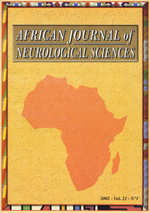
|
African Journal of Neurological Sciences
Pan African Association of Neurological Sciences
ISSN: 1015-8618
Vol. 20, No. 1, 2001, pp. 17-20
|
 Bioline Code: ns01005
Bioline Code: ns01005
Full paper language: French
Document type: Research Article
Document available free of charge
|
|
|
African Journal of Neurological Sciences, Vol. 20, No. 1, 2001, pp. 17-20
| fr |
ASPECTS CLINIQUES ET ETIOLOGIQUES DES EPILEPSIES DANS UN SERVICE DE NEUROLOGIE A NOUAKCHOTT, MAURITANIE
Hamidou TRAORE, Pierre-Marie PREUX, Mohamadou. DIAGANA, Michel DRUET-CABANAC, Caroline DEBROCK, Michel DUMAS
Résumé
Introduction:
Les épilepsies dans la pratique médicale quotidienne constituent une
cause majeure de consultation en Neurologie en Mauritanie. Sa fréquence en
population générale est autour de 8‰. En étudiant l'épilepsie
mal connue en Mauritanie, sous les aspects cliniques et étiologiques, cet
article se propose de découvrir les spécificités de cette affection
dans ce pays. Le but de ce travail est de montrer les réalités de l'épilepsie
en milieu hospitalier et de discuter les avantages et les inconvénients de
l'application d'un questionnaire standardisé.
Méthodes:
Cent cinquante patients épileptiques Mauritaniens ont été examinés
de manière prospective en 1997 et ont répondu au questionnaire d'investigation
de l'épilepsie en zone tropicale recommandé par la Ligue Internationale
Contre l'Epilepsie.
Résultats :
Les crises généralisées représentent 58,7 % des cas contre
41,3 % de crises partielles. Les crises sont le plus souvent déclenchées
pour la première fois par la fièvre. Les antécédents de crises
existent dans 10,7 % des cas. Les facteurs infectieux sont peu en cause (17,5
%), certainement à cause de la bonne couverture vaccinale (89,3 %). Le bilan
étiologique est insuffisant et la thérapeutique a recours au phénobarbital
en première intention.
Conclusion:
Malgré l'insuffisance des examens complémentaires, l'application d'un
questionnaire standardisé a permis de mieux connaître les facteurs favorisants
des crises épileptiques. Les perspectives d'avenir porteront sur l'étude
en population générale et l'approfondissement du bilan complémentaire.
Mots Clés
Afrique, épidémiologie, épilepsie, Mauritanie
|
| |
| en |
Hamidou TRAORE, Pierre-Marie PREUX, Mohamadou. DIAGANA, Michel DRUET-CABANAC, Caroline DEBROCK, Michel DUMAS
Abstract
Background :
Epilepsy constitutes a very frequent clinical presentation in our outpatient clinic
of Neurology in Mauritania. Its frequency in general population is at least 8‰.
The purpose of this paper is to describe the specificities of epilepsy in this
country, in particular the clinical and etiological aspects. The aim of this work
is to demonstrate the daily realities of epilepsy in our hospital and also to
discuss the interests and the limits of a standardised questionnaire.
Methods :
One hundred and fifty epileptic Mauritanian patients were examined prospectively
in 1997 and were interviewed by the questionnaire for investigation of epilepsy
in tropical countries, supported by the International League Against Epilepsy.
Results:
Generalized tonic clonic seizures constitute 58.7% of the cases compared to 41.3%
of partial seizures. Fever was often a precipitating factor for the onset of the
seizures. A family past medical history of seizures was described in 10.7% of
the cases. Infectious factors were unfrequent (17.5%) probably because of the
good vaccinal coverage (89.3%). The etiological paraclinical exams were insufficient
and the treatment was phenobarbital, at least as first line drug.
Conclusion:
The application of a standardised questionnaire allows a better understanding
of the precipitating factors of the epileptic seizures. Perspectives will be to
initiate a study in the general population and the extension of the paraclinical
examinations.
Keywords
Africa, epidemiology , epilepsy, Mauritania
|
| |
© Copyright 2001 - African Journal of Neurological Sciences
Alternative site location: http://www.ajns.paans.org
|
|
